Domestic Design Developments 1806-2006
(c) Antique Metalware Society
Small extracts can be used with acknowledgements to 'Oldcopper.org' website.
Helpful comments are very welcome.
Paper for Copper Industry Conference, SF2M, Sept 2006, now published in the proceedings: 'Copper - Better Properties for Inovative Products', Jean-Marie Welter (Ed.) Wiley-VCH. ISBN 13-978-3-527-31884-1, 332pp.
DESIGN IMPLEMENTATION - PRODUCTION METHODS
DESIGNERS’ STYLE PERIODS – ANTIQUE TO MODERN
INTRODUCTION
Copper and brass have been used for centuries for the production of functional, attractive items for the home. These started with cookware and lighting products and soon included large quantities of useful, decorative items for all rooms. The colour and comfortable warmth of the metals were highlighted by attractive, stylish designs that caught the imagination of the householders and the eyes of visitors. Design trends have varied with fashion and have been frequently revived. Today’s designers do well to study and perhaps obtain inspiration from products that are still appreciated years after they were made.
This paper gives a very brief introduction to a fascinating subject.
Products in the House
In the kitchen are found kettles, saucepans, skillets, strainers and other tools. The fireside is frequently the focal point of the décor of a living room and can be equipped with fire surrounds, firescreens, andirons, trivets bellows, toasting forks and ale warmers. Much lighting equipment is made of brass whether the light comes from gas, oil, candles or electricity. Tableware needs trays, food warmers, gongs, stands, jugs, dishes, tea and coffee pots, flatware and many other accessories from corkscrews to nutcrackers. The home office uses paper knives, penstands, inkwells, paper weights, paper clips, letter racks, tobaccanalia and money boxes. In the bedroom there can be brass beds, candlesticks, water cans, warming pans, toilet items, buttons, buckles, curtain rails and metal framed mirrors. In sitting rooms can be found many types of copper and brasswares such as jardinières, bookends and decorative souvenirs and ornaments with sentimental attachments. All round the house can be found architectural hardware including hinges, knobs, knockers, finger plates, locks, stair fittings and window furniture.
DESIGN IMPLEMENTATION - PRODUCTION METHODS
Besides the influences of fashions, the design of the domestic copper and brasswares just mentioned has altered as production methods have changed and become more economical. With care it is possible to update production methods and still maintain the qualities for which the metals are chosen so that items are still satisfying for the user.
Casting has always been the most obvious way of making shaped articles and is usually an essential preliminary to subsequent forming. Good quality sand and lost wax casting methods were well established prior to 1820.
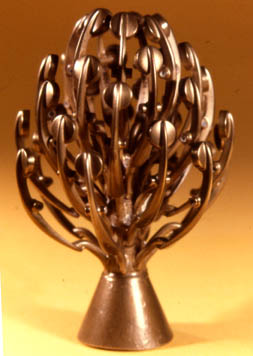 Since then die casting in permanent moulds and continuous casting techniques have been developed to give a wider range of precision production techniques.
Since then die casting in permanent moulds and continuous casting techniques have been developed to give a wider range of precision production techniques.
(Plate 1 A tree of clarinet keys precision cast to save the cost of assembling each one from several parts.)
Forging started as the first method of forming metal to shape. Large reductions were not possible until heavy hot stamping hammers were powered by water mills but hand hammering was and still is used for many finishing processes such as planishing to a very pleasant appearance.
Rolling mills had been introduced during the 17th century when they were mostly powered by water wheels. Capabilities increased with the introduction of steam power followed by the introduction of electric motors. This process has seen many comparatively recent improvements such as full electronic control of front and back tension on feed rolls, roll grinding and mill stressing techniques for the precision control of gauge and roll surfaces. Finishes can now be offered to suit requirements from retention of drawing lubricants to a fully reflective mirror finish.
A stamping machine was patented in 1769 for the production of items such as coinage, buttons, buckles and similar items. With the introduction of steam powered presses from 1789 and the use of collared dies, coining became a precision process.
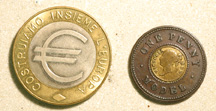 Coining was developed by the Chinese and was in use in Europe by the Celts and Greeks well before Roman times. The production of quality coins and tokens improved tremendously after the introduction of the steam driven press.
Coining was developed by the Chinese and was in use in Europe by the Celts and Greeks well before Roman times. The production of quality coins and tokens improved tremendously after the introduction of the steam driven press.
(Plate 2 Bimetallic coinage was first struck in Birmingham in 1848.)
Spinning is a craft that developed when it became possible to keep a lathe revolving in one direction rather than use a bow string to drive it in alternate directions. After polishing, little evidence of forming marks is retained. Deep drawing is now used to produce many straight-sided vessels such as vases and saucepans.
Wire drawing was developed in Nürnburg during the 14thcentury. Initially it was needed for the production of comb wire for preparing wool fleeces for spinning. By 1820 it was also well established for the production of the brass chains used to suspend fittings for lighting and similar applications.
Lathe turning has long been used for the manufacture of shaped knobs and threaded fasteners. With the introduction of numerically controlled machining the economics of production have improved the competitivity of brass.
Tube drawing was only possible in 1806 after forming and joining strip but the techniques used were very effective. Seamless tube drawing techniques were introduced during the 19th century, which made possible the production of long lengths of precision solid drawn tube with no risk of seam failure.
Extrusion was introduced in 1894 by Alexander Dick and opened up possibilities for the design of many more products in a more adventurous way.
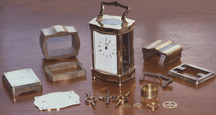 (Plate 3 An excellent reproduction carriage clock can now be made using custom made extrusions and stampings.)
(Plate 3 An excellent reproduction carriage clock can now be made using custom made extrusions and stampings.)
Electroplating was introduced commercially in the 1830’s. Initially this was used for plating copper alloys with a decorative silver coating but was soon used for refining copper and the production of art metalware by electrotyping. Nickel plating was introduced in the 1870’s and chromium plating soon afterwards to provide a cheaper and more durable surface finish than silver.
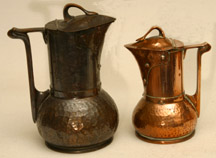 From the 1930s the use of surface coatings has frequently hidden the warmth and friendliness of the underlying copper and brass products. Where the warm copper surface is showing, some owners like it polished while others prefer it with a patina that may be either naturally formed or an applied coating.
From the 1930s the use of surface coatings has frequently hidden the warmth and friendliness of the underlying copper and brass products. Where the warm copper surface is showing, some owners like it polished while others prefer it with a patina that may be either naturally formed or an applied coating.
(Plate 4 Examples of both polished and patinated jugs available to choice.)
Properties Preferred
Besides their colours, copper and its alloys benefit from a phenomenal range of optional combinations of strength, hardness, ductility, machinability, wear resistance, thermal or electrical conductivity, corrosion resistance, ease of manufacture, ease of finishing, perceived product value and the recyclability of process scrap. The effects of composition and fabrication needed to optimise this multiplicity of values can only be considered and evaluated through experience.
DESIGNERS’ STYLE PERIODS – ANTIQUE TO MODERN
Early designs for metalware for domestic use were purely functional in that they were for cookware or platters for food use on the table. Production of basic designs has continued but at the same time designers and users of functional items have appreciated the warm colours of copper and brass.
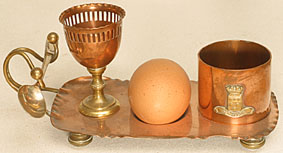 The products made take pride of place in an interior décor scheme. This table shows some of the names applied to styles of décor during the period covered. The dates are very approximate and show the formative periods. The styles have been extended and revived frequently.
The products made take pride of place in an interior décor scheme. This table shows some of the names applied to styles of décor during the period covered. The dates are very approximate and show the formative periods. The styles have been extended and revived frequently.
A splendid holder for the morning boiled egg made by Fischer.
Table 1 Some Style Dating Periods
Dates |
British |
French |
German |
USA |
Other |
1760–1811 |
Georgian |
Empire |
Empire |
Empire |
Functional |
1811–1830 |
Regency |
Restoration |
Biedermeier |
Later Federal |
|
1821–1836 |
Georgian |
Revival |
|
Shaker |
|
1837–1860 |
Early Victorian |
2nd Empire |
Revival |
Early Victorian |
Eclectic |
1860–1880 |
Mid Victorian |
|
|
Mid Victorian |
Arts and Crafts |
1880–1901 |
Late Victorian |
|
Jugenstil |
Late Victorian |
Colonial Revival |
1901–1910 |
Edwardian |
3rdRepublic |
Wiener Werkstätte |
|
Art Nouveau |
1919-1933 |
|
|
Bauhaus |
|
Modernist |
1925 on |
Art Déco |
Art Déco |
Art Déco |
Art Déco |
|
1945 on |
|
|
|
|
Eames |
Some of the non-traditional styles deserve comment although product design criteria are sometimes blurred.
500BC Celtic Art
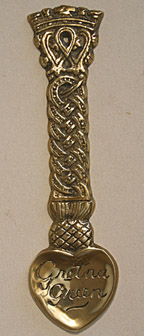 The Celts lived across Europe from Germany and Switzerland to France and Britain. Many motifs also found in Greek and Asian art were interpreted in an abstract, geometrical direction, with curved shapes and empty spaces balancing each other in asymmetrical patterns, often deliberately suggesting movement. The style continued developing to a peak with the 6th century production of the Book of Kells in Ireland and is enjoying another revival now.
The Celts lived across Europe from Germany and Switzerland to France and Britain. Many motifs also found in Greek and Asian art were interpreted in an abstract, geometrical direction, with curved shapes and empty spaces balancing each other in asymmetrical patterns, often deliberately suggesting movement. The style continued developing to a peak with the 6th century production of the Book of Kells in Ireland and is enjoying another revival now.
( Plate 5 A Scottish love spoon with an attractive and decorative reproduction Celtic design.)
1815 Biedermeier
Biedermeier was an influential style of furniture design from Germany during the years 1815-1848 based on utilitarian principles. It covers the fields of literature, music, the visual arts and interior design from the end of the Napoleonic Wars to 1848, the year of the European revolutions. It contrasts with the Romantic era that preceded it.
1821 Shaker
The Shaker style includes clean lines and lack of ornamentation. In America, the Shakers were pioneers of the principles of form and function promoted later by architects and designers such as William Morris. The style was established with the publication in 1821 of the Millennial Laws that established commonalities of designs throughout the Shaker communities with the furniture and furnishing designs based on English rural designs.
1859 Arts and Crafts.
William Morris is frequently said to be the founder of the Arts and Crafts movement, introducing a unified decoration concept for the whole house including simple, effective designs executed by craftsmen. He helped the foundation of the Art Workers’ Guild and the Arts and Crafts Exhibition Society. Prominent guilds and schools were set up in places such as Newlyn, Keswick, Glasgow and Birmingham. In the 1880s he was promoting the better use of machines, exhibiting products Europe-wide and comparing notes with fellow designers.
 By 1896, the chairman of Morris & Co was W A S Benson who had a factory producing tableware and lighting products of very high quality that command appreciative prices today.
By 1896, the chairman of Morris & Co was W A S Benson who had a factory producing tableware and lighting products of very high quality that command appreciative prices today.
(Plate 6 A Benson spirit kettle for home use.)
Around 1900, Elbert Hubbard was inspired by William Morris and determined to introduce similar ideas in America. He established the Roycroft Community as a business enterprise founded on Arts and Crafts ideals in Aurora, New York State. The master craftsman in the Copper Shop from 1908 was Karl Kipp, banker turned coppersmith, who organised and inspired the designs and production of the shop to make it very successful. This included the design of the trademark ‘R’ inside a modified ankh. Much work was done on the production of artificial patination that would look attractive for many years without maintenance. He later left to found his own ‘Tookay’ Shop (KK). The Roycroft Community thrived by selling to department stores but was hit by cheap imitations and closed in 1938. Several other quality copper shops were established in America.
Many other workshops were established worldwide that developed into design-leading factories making good quality copper and brassware that is still be found and cherished today. Just a few examples of makers marks to be seen include: Benham, Bing, Clews, Dalderop, Deffner, Fearncome, Fischer, Heinrichs, Kayser, Loveridge, Skultuna, Soutter, Townshend, and wmf (Würtemburgische Machin Fabrik).
1876 Art nouveau
Dr Christopher Dresser, designer and theorist, visited Japan and returned inspired with a Japanese style of design. It was a complete change from the academic flourishes of Victoriana but retained sinuous curved and undulating lines. He produced many designs with a great range of styles for a wide spread of products. For domestic metalware his ideas embodied form, function and simplicity combined with good balance and a flair that ensured a good reception. His influences are still felt and quoted. Many other designers across Europe were also inspired and the free-flowing lines of art nouveau designs recur frequently though the 20thcentury.
 The style enjoyed a vogue in the USA from c1890-1910. (Plate 7 Handle designs attributed to Dr Charles Dresser and popular with many manufacturers.)
The style enjoyed a vogue in the USA from c1890-1910. (Plate 7 Handle designs attributed to Dr Charles Dresser and popular with many manufacturers.)
1876 Colonial Revival and other American Influences
This represents a trend start with the intention of recreating interest in early English and Dutch traditions including Georgian and Adams styles. The Eclectic movement drew on the full spectrum of architectural tradition including Ancient Classical, Medieval, Renaissance Classical, or Modern for stylistic inspiration. Unlike the free stylistic mixtures that dominated the preceding Victorian era, the Eclectic movement stresses relatively pure copies of these traditional styles as originally built but several styles may be included in any design. The Californian counterpart of this trend was ‘Mission Style’ which includes Hispanic influences. Neoclassical designs followed soon afterwards with similar concepts.
1896 Jugendstil (Youth Style)
This is a style of decorative art similar to art nouveau founded in 1896 by Georg Hirth. It was popular during the late 19th and early 20th centuries and is frequently revived. It was centred in München, promoted by Henry Ven de Velde and had a significant influence on Peter Behrens of AEG amongst others.
1903 Wiener Werkstätte Style
This was founded in 1903 by Joseph Hoffman and Koloman Moser with members of the Vienna Sezession with the aim of making all facets of human life into one unified work of art. Many high quality schemes of interior decoration were developed under the organisation’s motto: ‘Better to work 10 days on one product than to manufacture 10 products in a day’. The brand trade mark was a double ‘W’ monogram inside a square box. It closed in 1932.
 Much of the decorative bronzework bears the name of Hagenauer Wien founded by Karl Hagenauer in 1898. The trade mark is WHW (Werkstätte Hagenauer Wien).
Much of the decorative bronzework bears the name of Hagenauer Wien founded by Karl Hagenauer in 1898. The trade mark is WHW (Werkstätte Hagenauer Wien).
(Plate 8 The classic concentric hedghogs and curious terrier dog designed by Walter Bosse for Hagenauer of Austria.)
1919 Bauhaus
The policy of the first Director, Walter Gropius, was that all the arts should be brought together under the primacy of architecture and practised as crafts in the sense taught by William Morris. In 1919 he merged the fine arts college in Weimar with the arts and crafts school to form the Staatliches Bauhaus. From 1923 the metal workshop was headed by Lásló Moholy-Nagy and Joseph Albers who lead the change from crafts to machine aided production. In 1925 the Bauhaus was moved to a new building in Dessau and the main designers for metalwork became Marianne Brandt and Wilhelm Wagenfeld.
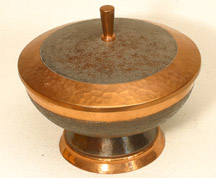 From 1930 the Director was the architect Mies van de Rohe. When the Bauhaus was disbanded in 1933 most of the principals moved to America where their minimalist design principles became very influential.
From 1930 the Director was the architect Mies van de Rohe. When the Bauhaus was disbanded in 1933 most of the principals moved to America where their minimalist design principles became very influential.
(Plate 9 Sugar bowl with lid superbly designed and finished by Hans Przyrembel.)
1925 Art Déco.
The simple geometric styles were introduced in 1925 at the Paris Exposition Internationale des Arts Décoratifs et Industriels which concentrated on individuality and fine workmanship. Later the trend was towards a vogue for streamlining everything. As with the Bauhaus, the emphasis for the style switched to machine production and went further towards economic mass production. There was a vogue for the revival of art déco in the 1960s and 1970s.
Chase Brass and Copper Company entered the art metalware market during the early 1930s in competition with other American firms such as Manning Bowman and Revere Copper. Their designs for elegant modern objects in the art deco style that a cult following was started that continues today.
 (Plate 10 Examples of art deco domestic tableware made by Chase Brass and Copper Co.)
(Plate 10 Examples of art deco domestic tableware made by Chase Brass and Copper Co.)
1941 Modernist Eames Designs
Charles & Ray Eames set up their design studio in Los Angeles and started forming plywood to make functional, attractive shapes for chairs. The Eames' furniture designs and other interior décor are seen as synonymous with mid-20th century Corporate America.
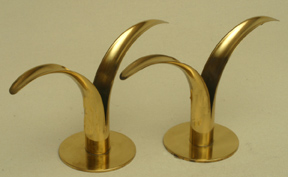 Many products designed since these times are thought to be suitable for Eames architecture.
Many products designed since these times are thought to be suitable for Eames architecture.
(Plate 11 A pair of candlestick to modernist design made by Ystad)
FORM AND FUNCTION
To follow the way in which design and production have interacted it is useful to look at the products. For this brief paper the best items to consider are kettles and coffee sets; many other products are being studied. They offer a wealth of scope and include a few of the 240 designs collected to date.
Standard Kettles
The basic design of copper kettle used to be made mainly by hand from six pieces of copper with the main joints fabricated by ‘dovetailing’ and brazing. This durable product has been in production for all of the 200 years considered. Handles were mounted on brass castings and have varied to include better heat insulation. For production economy there can be a switch to lap-seamed joints.
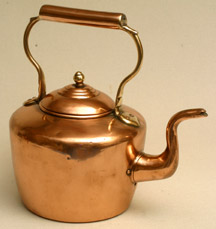 Radical design ideas have included heptagonal art deco and many other shape variations. For gas heating with greater efficiency the base of the kettle can now include a radiant coil.
Radical design ideas have included heptagonal art deco and many other shape variations. For gas heating with greater efficiency the base of the kettle can now include a radiant coil.
(Plate 12 Standard design of kettle made throughout the last two centuries.)
Spirit Kettles
To provide elegant service of hot water at the tea-table, budgets could be higher and designers use their ingenuity and flair to get the best looking practical kettle, stand, tilting arrangement and spirit burner. Every one of the names of the styles mentioned has been used to describe the products offered.
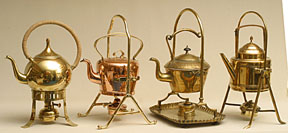 They were made of copper or brass and some were offered silver-plated. Most have now lost the fugitive silver coating and reverted to the warm colour of copper.
They were made of copper or brass and some were offered silver-plated. Most have now lost the fugitive silver coating and reverted to the warm colour of copper.
(Plate 13 Spirit kettles made by Eisenloffel, Bing, Soutter and wmf)
Electric Kettles
With the introduction of electricity at the turn of the 20thcentury there was naturally a need to use it to heat water. Initial designs included a plate-shaped heater joined to the underside of a standard design. Later it became usual to have a heating element immersed directly in the water. Recent designs have reverted to the element being underneath again. The most significant development was that of the Russell Hobbs K1 kettle in the early 1950s. On boiling, switching off the power is effected by a vapour controlled thermostat.
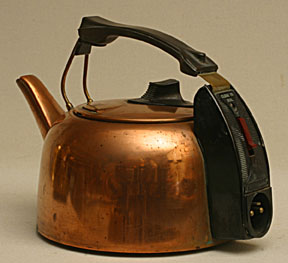 The copper body is pressed from a circle of copper made to very strict requirements for surface finish, hardness and grain size so that there is no need for an interstage anneal. The product is now made up of about 110 components so failure of any one of them cannot be tolerated.
The copper body is pressed from a circle of copper made to very strict requirements for surface finish, hardness and grain size so that there is no need for an interstage anneal. The product is now made up of about 110 components so failure of any one of them cannot be tolerated.
(Plate 14 Russell Hobbs Electric Kettle model K2R of c1956.)
Coffee Sets
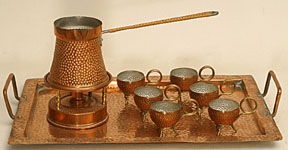 A spirit-warmed set for Turkish coffee made by wmf.
A spirit-warmed set for Turkish coffee made by wmf.
With the development of percolators for making coffee the copper industry was well able to meet the needs for an integrated system including the containers for the coffee, cream and sugar.
Generally a tray was supplied and sometimes a set of matching copper cupholders and saucers. 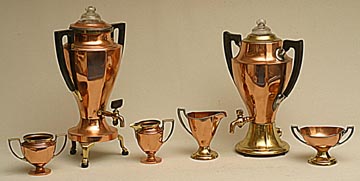 Some were warmed by an alcohol lamp; later designs were electric.
Some were warmed by an alcohol lamp; later designs were electric.
(Plate 15 Coffee set made by Landers Friary Clark and an electric version by Manning Bowman.)
CONCLUSION
This brief paper indicates that the products of the copper and brass industries have met the needs of the domestic appliance industry for the past two centuries. A wealth of design and production experience has accumulated and is being documented from surviving durable examples acquired recently. It will be available for the next generation of designers and help provide useful success stories to build upon.
REFERENCES
Literature on styles, materials and collectibles:-References.
Home Page.
A